The value of a 1920 wheat penny can vary greatly based on several factors, including the mint mark, the coin’s condition, and whether it has any special errors. Below is a breakdown of the 1920 wheat penny values according to different conditions and mint marks:
1920 Wheat Penny Value Chart
| Mint Mark | XF45 (Extremely Fine) | MS62 (Mint State) | MS65 (Mint State) | MS67 (Mint State) |
|---|---|---|---|---|
| 1920 (P) No Mint Mark | Brown: $10 | Brown: $28 | Red and Brown: $32 | Red: $45 |
| Brown: $160 | Red and Brown: $175 | Red: $300 | Red: $8,000 | |
| 1920-D | Brown: $28 | Brown: $125 | Red and Brown: $160 | Red: $215 |
| Brown: $450 | Red and Brown: $700 | Red: $2,600 | N/A | |
| 1920-S | Brown: $26 | Brown: $165 | Red and Brown: $235 | Red: $550 |
| Brown: $825 | Red and Brown: $2,150 | Red: $20,000 | N/A |
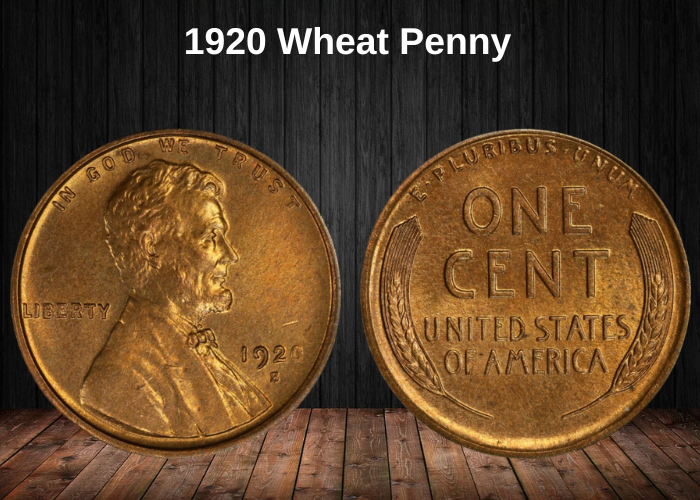
History of the 1920 Penny
The 1920 penny, also known as the Lincoln penny or Wheat penny, carries rich history and design elements that distinguish it as an iconic part of American numismatic culture.
Names and Significance
- Lincoln Penny: The obverse (heads side) of the coin features the image of President Abraham Lincoln, making it one of the most famous U.S. coins. Lincoln was the first U.S. president to appear on a coin, breaking a long-standing tradition against depicting real people on currency.
- Wheat Penny: The reverse (tails side) shows two ears of wheat, which is why these pennies are commonly called wheat pennies. The design was used from 1909 until 1958, when it was replaced by the Lincoln Memorial.
Historical Context
- The 1909 Lincoln penny was significant not only for its design but also because it marked the centenary of Lincoln’s birth. This was the first time a real person appeared on U.S. currency, reflecting the deep respect the nation had for the president, especially following his assassination.
- The design on the reverse, featuring wheat, continued through 1958, after which it was replaced by the Lincoln Memorial design, which was in circulation until 2008. Today, Lincoln pennies feature the Union shield design, introduced in 2010.
Designer: Victor David Brenner
- The 1920 penny’s design on both sides was the work of Victor David Brenner, a Russian-born artist who immigrated to the U.S. in 1880. He trained as a metalworker, engraver, and die cutter, spending time in Paris to hone his craft.
- Brenner’s work on the Lincoln penny is perhaps his most famous achievement. However, his initials, VDB, which were originally included on the reverse, caused controversy. The Mint removed them, considering them too prominent, despite Brenner’s objections.
- In 1918, Brenner’s initials were reinstated, but this time they were discreetly placed on the bottom edge of the obverse near Lincoln’s shoulder, making them more subtle and acceptable to the public.
Key Features of the 1920 Penny
- Obverse (Heads): Shows a left-facing portrait of Abraham Lincoln, with the inscription “LIBERTY” and the year “1920”, along with “IN GOD WE TRUST” at the top.
- Reverse (Tails): Features two ears of wheat, with the words “E PLURIBUS UNUM” at the top, “ONE CENT” in the center, and “UNITED STATES OF AMERICA” along the bottom.
Despite the 1920 penny being quite common, its historical context, unique design, and the significance of the VDB initials make it a key piece for collectors.
Features of the 1920 Penny
The obverse of the 1920 penny
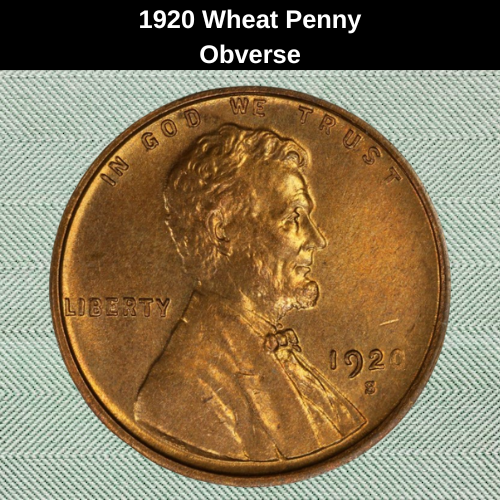
The obverse of the 1920 penny displays the iconic portrait of Abraham Lincoln, which is still featured on modern pennies today, with the only difference being that newer coins have a slightly lower relief.
The image shows Lincoln in profile, facing right. Artist Victor David Brenner imagined Lincoln as he might have looked while reading to a child, capturing a serene and thoughtful expression.
Key elements on the obverse:
- The well-known phrase “IN GOD WE TRUST” curves over Lincoln’s portrait along the coin’s upper edge.
- “LIBERTY” is inscribed to the left of the portrait, and the date appears on the right side.
Pennies minted in Philadelphia do not carry a mint mark, while those from Denver feature a small “D” and those from San Francisco display a small “S”, typically located just below the date.
The reverse of the 1920 penny
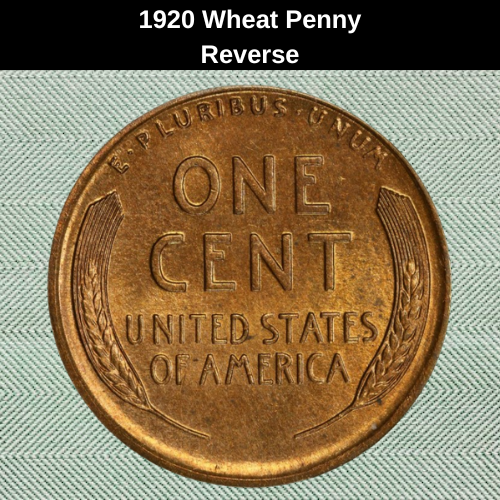
The reverse of the 1920 penny features a straightforward design with two ears of durum wheat, which curve around the edges of the coin, providing a natural frame for the other elements.
At the center, you’ll find the inscription “ONE CENT”, which is the coin’s denomination. Below this, in slightly smaller lettering, is “UNITED STATES OF AMERICA”. The smallest text on the reverse is the Latin motto “E PLURIBUS UNUM”, which appears at the top, running along the upper edge of the coin.
This motto translates to “From many, one”, symbolizing the formation of the United States from the union of individual states.
Other features of the 1920 penny
The 1920 penny is made of bronze, with a composition of 95% copper and 5% zinc and tin. This mixture gives the penny its characteristic color and weight. Over time, the composition of Lincoln pennies has changed, and today’s pennies are primarily made of zinc coated with copper.
Even though the materials have evolved, the 1920 penny shares the same size as modern pennies. It has a diameter of 19 millimeters and weighs 3.11 grams.
The copper content in the 1920 penny causes the coin’s color to vary. Newer pennies or those with minimal handling retain a red color, but over time, as they are exposed to the air and circulation, the color darkens to brown.
In terms of coin grading, pennies are categorized as:
- Red: If at least 90% of the coin’s surface remains red.
- Red and Brown: A mix of both.
- Brown: If the coin is predominantly brown.
Typically, red coins are more valuable than their brown counterparts. Coin condition and the presence of any rare features or errors can also affect its value.
1920 Penny Grading
Here’s a general guide to the coin grading scale used to evaluate the condition and value of a 1920 wheat penny or any other coin:
- 1 – Basal State-1: Very heavily worn, barely recognizable.
- 2 – Fair: Considerable wear, major details still visible.
- 3 – Very Fair: Noticeable wear, major details still discernible.
- 4, 5, 6 – Good: Heavy wear but basic features still visible.
- 7, 8, 10 – Very Good: Some wear but all major details are visible.
- 12, 15 – Fine: Light wear, with most major details visible.
- 20, 30 – Very Fine: Slight wear, sharp details, minimal fading.
- 40 – Extremely Fine: Minor wear, sharp details, slightly less luster.
- 50 – About Uncirculated: Minor signs of wear but otherwise like new.
- 60 – Mint State: No wear, full original luster.
- 65 – Mint State: High-quality with a few minor imperfections.
- 70 – Mint State: Perfect coin, flawless with no visible imperfections.
To determine the exact value of your coin, it’s essential to match the coin’s grade with its condition. You can use this scale to help you assess your coin or check with a coin grading service for an accurate evaluation.
1920 Penny Value Guides
1920 No Mint Mark Penny Value
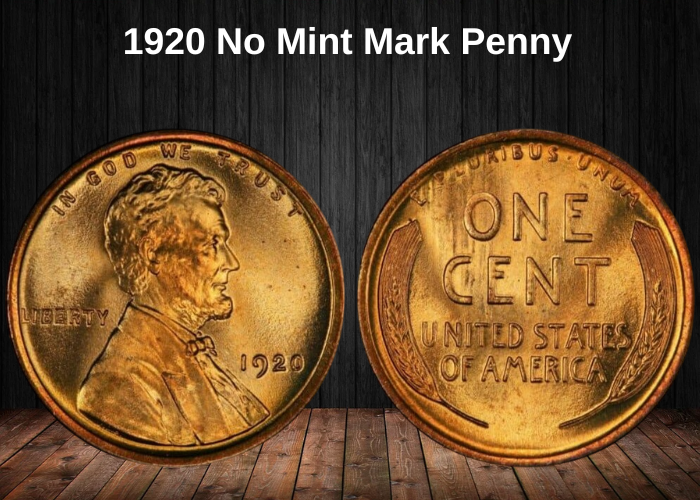
Coins struck in Philadelphia will not have a mint mark on the obverse. If you don’t see a “D” or “S” under the date, you’re holding a Philadelphia penny.
Even a brown 1920 Philadelphia penny in poor condition is typically worth at least $1. However, the value can significantly increase for coins in better condition.
Grading System:
- Coins are graded on a scale from 1 to 70, where 1 represents the worst condition, and coins above 60 are considered in “mint state”. Coins graded 65 or higher are classified as “gems”.
Value Breakdown:
- Brown 1920 Philadelphia Pennies:
- Grade 1: $1 (poor condition)
- Grade F-12 (Fine): Around $2
- Grade 40-45 (Extremely Fine): About $10
- Grade MS60 (Mint State): Starts at $24
- Grade MS65: Around $160
- Red and Brown Coins:
- Grade MS60: Around $26
- Grade MS66: Up to $350
- Red Coins:
- Grade MS62: Valued around $45
- Grade MS67+: The finest examples are worth about $20,000 each, according to the PCGS grading service.
The overall value of the 1920 Philadelphia penny depends largely on the coin’s grade, with higher-grade coins commanding significantly higher prices, especially for those in red condition.
1920 D Penny Value
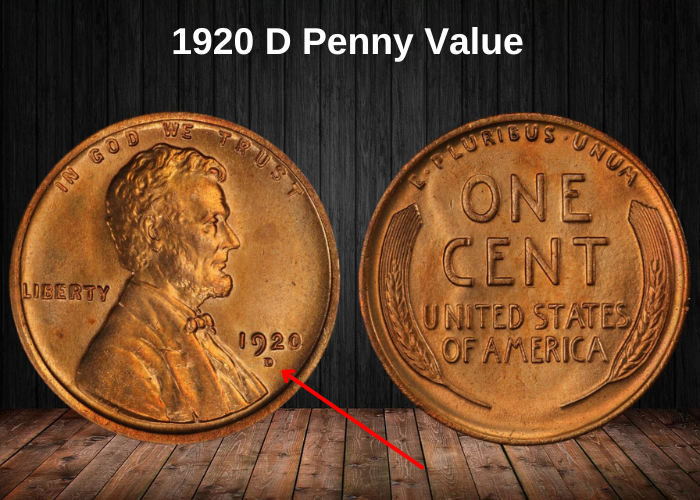
If your 1920 penny has a “D” mint mark beneath the date, it means it was struck at the Denver Mint.
In 1920, Denver produced far fewer pennies than Philadelphia, with just over 49 million minted compared to 310 million in Philadelphia. As a result, 1920 Denver pennies tend to be more valuable at most grades.
Value Breakdown for 1920 Denver Pennies:
- Brown 1920 Denver Penny:
- Grade XF45: Around $28 (in extra fine condition)
- Grade MS60 (Mint State): $100
- Grade MS63: $160
- Grade MS65: $450
- Red and Brown Coins:
- Grade MS60: $100
- Grade MS63: Around $250
- Grade MS65: Around $700
- Grade MS66: The highest known value is $2,400 for a red and brown coin at this grade.
- Red 1920 Denver Pennies:
- Grade MS62: Starts at $215
- Grade MS66: The highest known grade for red pennies is MS66, with 10 certified at this level. These coins are valued at $21,500 each.
Denver-struck 1920 pennies are less common than their Philadelphia counterparts, making them more valuable at most grades. Especially for higher-grade coins, the value increases significantly, with red MS66 coins being particularly rare and valuable.
1920 S Penny Value

The San Francisco Mint struck just over 46 million pennies in 1920, and these coins can be identified by the small “S” mint mark beneath the date.
Due to their relative scarcity, San Francisco 1920 pennies are generally more valuable than their Philadelphia or Denver counterparts, especially at higher grades. The PCGS estimates that only around 500 examples of the 1920-S penny exist at all grades.
Value Breakdown for 1920 San Francisco Pennies:
- Circulated Grades:
- Brown 1920-S Penny (XF45): $26 (a bit less than the Denver equivalent)
- Mint State Grades:
- Brown Coins:
- MS60: $100
- MS63: $225
- MS65: $825
- Red and Brown Coins:
- MS60: $150
- MS63: $325
- MS65: $2,150
- Brown Coins:
- Red Coins:
- MS60: Starting at $340
- MS65: $20,000
- Finest Example:
- Red Penny Graded MS65+: $50,000 (The highest known value)
San Francisco 1920 pennies, particularly those with the “S” mint mark, are rarer and more valuable than other mint varieties. Coins in mint state, especially red examples, fetch premium prices. The MS65 red 1920-S penny is especially valuable, with some examples reaching up to $20,000 or even $50,000 for the finest known specimens.
Rare 1920 Penny Error List
1920 D Penny, Rotated Reverse 15 Degrees
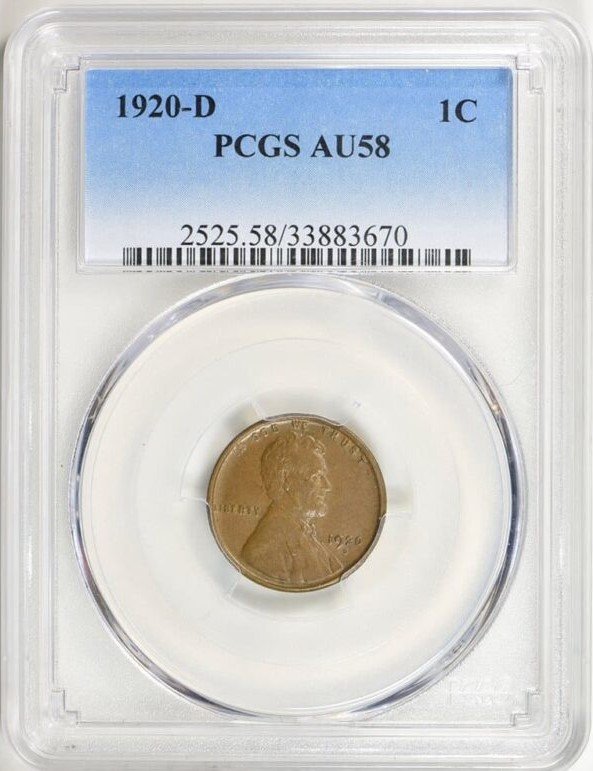
Errors that slip past the Mint’s quality assurance processes are indeed rare, and collectors value them highly, often willing to pay a premium for such unique coins.
One example of such an error is a 1920 penny struck in Denver, where the coin was somehow rotated in the collar before the reverse design was struck. As a result, the ears of wheat on the reverse appeared 15 degrees off their proper position.
Details of the Error Coin:
- Grade: AU58 (About Uncirculated), Brown
- Auction History: The coin sold on eBay for $59 in 2018.
- Current Value: The PCGS estimates its value at $85 today.
Collectors typically seek these off-center errors, making them valuable as they are not only rare but also carry historical and production significance.
1920 No Mint Mark Penny, Clipped Planchet
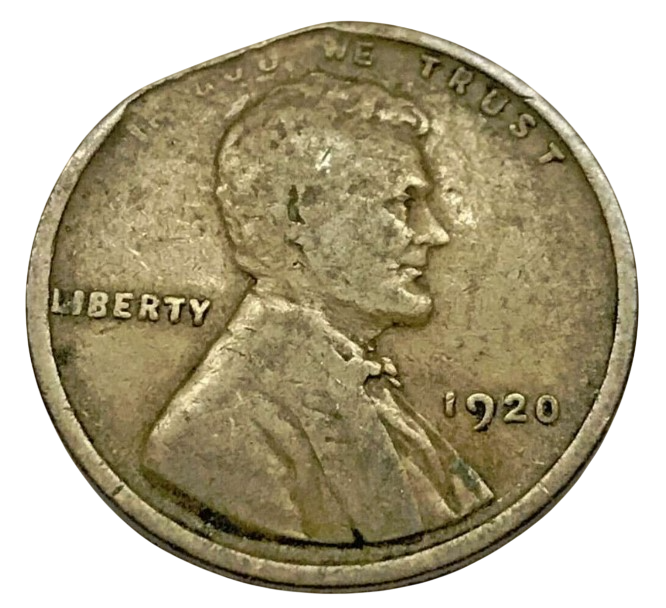
Sometimes, a blank—the piece of metal from which the coin is struck—ends up not in the right position when it’s cut from the strip of metal. This results in a curved “clip” being sliced from the edge of the planchet. The more dramatic the clip, the more valuable the coin becomes.
One example of this error is a 1920 penny struck in Philadelphia with a clipped planchet. The clip appeared on the right-hand side of the coin, with the obverse facing up, and it sliced into the very edge of the “0” in the date.
Details of the Clipped Planchet Error Coin:
- Grade: AU53 (About Uncirculated), graded by ANACS
- Current Listing: The coin was listed on eBay for $114 at the time of writing.
Coins with this type of error can be particularly appealing to collectors, especially when the clip is noticeable, as it adds a distinct and unique characteristic to the coin.
Where to sell your penny?
Now that you know the value of your penny, you might be wondering where to sell it. Don’t worry: here’s a guide to some of the best online platforms where you can easily sell your coins, along with their advantages and disadvantages.
Discover the best platforms for selling coins online (pros and cons).
FAQs
How much is a 1920 penny worth today?
The value of a 1920 penny depends on its condition and color. Even a brown coin in poor condition is worth more than its face value. However, if your coin is in mint state or has exceptional quality, it can be worth hundreds or even thousands of dollars.
Coin grading is a meticulous process, and even small differences in condition can greatly affect a coin’s value. For an accurate assessment, it’s best to watch coin grading videos to learn what to look for.
If you think your 1920 penny is in top condition, consider getting it professionally appraised. You can use reputable grading agencies like PCGS, NGC, or ANACS, but be aware that fees apply. It’s worth appraising if you believe your coin might be valuable.
How much is a 1920 D mint penny worth?
The value of a 1920 D penny depends on its color, condition, and whether it has any errors. As of July 2023, a brown 1920 D penny graded MS60 (the lowest mint state grade) is valued at $95 by PCGS. On the higher end, a 1920 D penny graded MS66 red can be worth up to $21,500.



















































